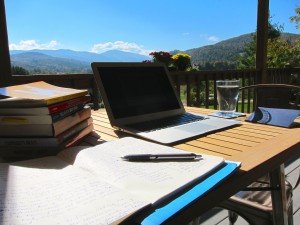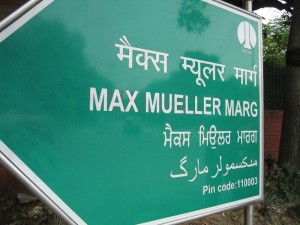Over the last sixty years, scholars of religion have variously described their work in terms of both field and discipline. Since the decline of the Eliadian/Structuralist paradigm in the 1980s and 1990s, scholars have been increasingly likely to describe what we do in terms of specific subfields shaped more broadly by disciplinary unity (though even as I say this, I can think of ways that even these subfields are both unified and pulled apart by “discipline” – this is the joy and frustration of Religious Studies!). We are fortunate, though perhaps not unique to have in the UVM Religion department several different broad disciplinary orientations in play at the same time. Our faculty do philosophical, ethnographic, historical and comparative work. This summer our two historians, Anne Clark and Ilyse Morgenstein Fuerst, scholars of Medieval Europe and Muslim South Asia respectively, each spent portions of their summers in specialized libraries doing research. Since my research generally entails chatting up monks in Thailand and China, it wasn’t completely clear to me what that meant. So I asked Anne and Ilyse some questions over email about what it was like to do their type of research.
What is an archive for you?
IMF: Great question. An archive to me is a collection—or series of collections—of rare material, which might be newspapers, photos or prints, maps, or books on a particular topic or from a particular area. But beyond a definition, to me, an archive immediately conjures a set of (obnoxiously lofty) sensations: the smell of old newspapers and manuscripts; the look of someone else’s handwriting; the feel of sometimes-crumbling, leather-bound volumes and whisper-thin onion paper; the sounds of dozens of other scholars scribbling notes in pencil, each uncovering something remarkable.
AC: In general I don’t think of myself as working in archives. For medievalists, “archive” usually refers to collections of documents like wills, charters, deeds, commercial records, etc., and I don’t work on that kind of material. I work with medieval manuscripts, which are books created before the invention of the printing press, so each book is a unique handmade artifact, distinct from every other book in the world. I think maybe it’s especially because I’m an American, living in a world where the built environment is perhaps 100 years old (my house is 118 years old and the Religion Department about the same) with few older artifacts as part of my daily life, that handling an 800-year old book is really a thrill.
What is the physical space where you were doing research?
IMF: I was working in the British Library, and spent most days in the Asian and African Studies Reading Room, though sometimes needed to use the Rare Books Room.
AC: I worked in the Österreichische Nationalbibiothek (Austrian National Library), in Vienna, in its beautiful Department of Manuscripts and Rare Books. The manuscript reading room was originally the library of an Augustinian monastery, attached to one of the Hapsburg palaces. As with most medieval manuscript collections, there are levels are security to go through, designed to protect the manuscripts from damage or theft.
Could you be more expansive about the literal space? Light? Dark? Comfortable? Crowded?
IMF: The Reading Room had rows of workspaces—long tables with individual “desks” designated by a change in the wood grain, an individual lamp, a few outlets, a desk number, and a call button to get a librarian. The room was cold, and while the light was decent for reading, I wouldn’t call it bright—rare materials like cold and dark. (After all, the books’ comfort far outweighs the researchers’.)
AC: Except for very hard wooden chairs (!), all the other appointments were quite good: wi-fi access; electric outlets at every desk (don’t forget to bring your electric current converter), good lighting through huge windows as well as individual desk lamps. There were rules that I inadvertently broke, like not realizing I had been assigned a particular desk, but since the reading room was not filled to capacity, no one scolded me or told me to move.
What is the process of doing research? How do you start the day?
IMF: I’m an early bird by nature, so my day usually looked like: retyping handwritten notes from the day before in the cafe while I waited for the BL to open, then immediately getting to work in a reading room!
AC: Because my time in Vienna was limited, I arrived at the library when it opened, picked up the manuscript and got set up in the reading room. I stayed pretty much glued to my chair, poring over the one manuscript I was researching. I had on my computer a scan of a similar manuscript, and my main work was a careful comparison of the two, and making detailed notes about the differences between them.
How do you get books – are you getting books?
IMF: The British Library has a system for requesting materials. Basically, I would search the catalogs, request an item (books, manuscripts, and collections of tracts or newspapers, usually), and specify when I’d like it to be delivered. But I arrived in London with a list of 10 must-have works, ranging from a tract published in 1813 in an Indian newspaper to a Persian manuscript to a set of prints related to the 1857 Sepoy Rebellion.
AC: I had written to the staff at the library in advance, so the manuscript, sometimes called the Lilienfeld Prayerbook, was waiting for me as soon as I checked in. This is important to do, because not all materials are always available. For example, I had also wanted to look at a related manuscript in Munich, the so-called Prayerbook of St. Hildegard, in the Bayerische Staatsbibliothek (Bavarian State Library), but when I had written ahead to inquire about access, I was told that it was not generally shown to scholars because of the availability of a photographic facsimile. This points to the dual role of the rare book library: to both protect and make available their resources. The library took the big step of allowing the manuscript to be photographed and published to make it widely accessible. Yet, for me to engage on a major analysis of the manuscript without seeing it “in the flesh” (and remember, the book itself is flesh, animal skin prepared into parchment), made me worried that I would miss something that couldn’t easily be seen in the photographs, and also makes me feel slightly tentative in writing about it. And, truth be told, I wanted that flesh to flesh experience.
Is this a political process? Does it help to chat with the librarians? To bribe them?
IMF: This isn’t political at the BL, and bribing wasn’t necessary. Though, to be fair, befriending the librarians did help: I could bolt to lunch and not forfeit my seat even when the room was at capacity (and decorum would dictate getting up meant giving up), and occasionally it meant I could bend the 3 day rule ever so slightly (and I do mean slight: a few hours!).
AC: Tom, maybe your experience in South Asia is showing here! No bribes were needed in Vienna, although I was required to purchase a library membership (ten euros for one year). And the staff was uniformly helpful, and fully comfortable with speaking to me in English so that I didn’t have to embarrass myself with pathetic attempts at German or sign language.
What are the materials you examine each day?
IMF: For the most part, on this trip, I was working with India Office Records, so my materials ranged from published, widely-circulated books to handwritten (Indic and Islamicate) language manuscripts and registers.
AC: My whole time was focused on one manuscript that I had researched in advance. It is a twelfth-century illustrated prayerbook, primarily in Latin with Middle High German additions. This is part of my larger project about how the juxtaposition of texts and pictures in medieval prayerbooks may have been used by their owners to stimulate emotional experience in their devotional practices.
What are the constraints of the location?
IMF: In the reading rooms, one cannot have food or water, for obvious reasons. This broke my 4 cups of coffee a day habit, quickly! One also cannot remove materials from the room, but also only (for the most part) had access to each item for 3 days. So, I guess, days were long and caffeine-free.
AC: In addition to no food or drink, the library also prohibits use of pens, and monitors strolled by occasionally to ensure that the manuscripts were being carefully used. We aren’t required to wear gloves, but there it is important to touch the books only minimally—just enough to set them up on the foam cushions provided and to gently turn the pages.
Do you enter the library/archive space knowing what you are going to read each day?
IMF: Sometimes! I tried to plan out what materials would arrive, and when. Days I needed to work exclusively with a Persian manuscript, for example, I planned for. Days that found me receiving a few ordered items—especially things I’d found via footnotes and in-text references—were a bit more surprising.
AC: I had a very focused plan to get through as much of that one manuscript as possible, but as with all manuscripts, you never know what you will find. There’s always the moment of first opening, the excitement and slight fear that I may not even be able to read the handwriting, or that it will be damaged, or that there will be unexpected marginalia, etc. So first I just look it over–the covers, the first and last pages, etc. And I had particular themes and subject pages that I prioritized. Also, because this was an illustrated prayer book, and my work investigates the relationship between text and image, I spent a fair amount of time looking closely at the pictures, and taking notes about them.
Sometimes when I interview someone, I have these moments where they say something I am not expecting, but it is exactly what I was hoping they would say (the reverse is also happens). In those moments, I can sometimes feel my heart racing with the excitement of the unexpected but sought for. If you have found something you don’t expect, do you know immediately?
IMF: Yes and no! On the one hand, I had the sense that what I was looking at was really important or special, maybe even a true gem of a source. On the other, sometimes I’d look at a piece of writing and know it was important to my research, that it would become something I’d use and return to, but wouldn’t quite be sure how it fit into my overall project just yet.
AC: Sometimes I am so busy copying as much as I can, that the impact of it doesn’t always hit me at first. Then it’s not till I’ve had time to do a more careful translation that I’ll discern the significance of even just a single word, or more likely, a pattern of words or phrases scattered throughout the whole work.



